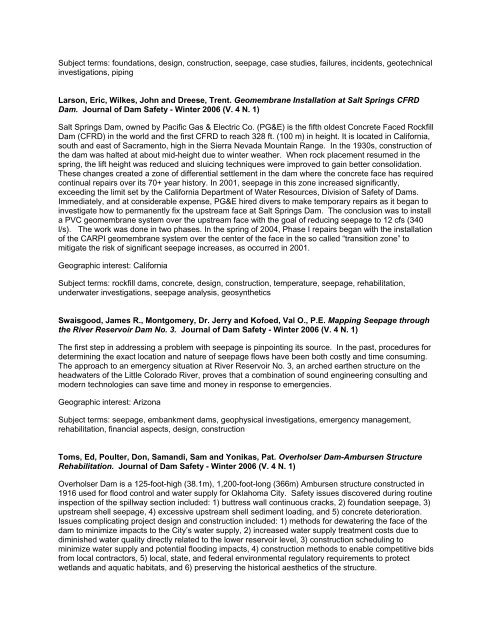Annotated List of Articles Published in the Journal of Dam Safety ...
Annotated List of Articles Published in the Journal of Dam Safety ...
Annotated List of Articles Published in the Journal of Dam Safety ...
- No tags were found...
You also want an ePaper? Increase the reach of your titles
YUMPU automatically turns print PDFs into web optimized ePapers that Google loves.
Subject terms: foundations, design, construction, seepage, case studies, failures, <strong>in</strong>cidents, geotechnical<strong>in</strong>vestigations, pip<strong>in</strong>gLarson, Eric, Wilkes, John and Dreese, Trent. Geomembrane Installation at Salt Spr<strong>in</strong>gs CFRD<strong>Dam</strong>. <strong>Journal</strong> <strong>of</strong> <strong>Dam</strong> <strong>Safety</strong> - W<strong>in</strong>ter 2006 (V. 4 N. 1)Salt Spr<strong>in</strong>gs <strong>Dam</strong>, owned by Pacific Gas & Electric Co. (PG&E) is <strong>the</strong> fifth oldest Concrete Faced Rockfill<strong>Dam</strong> (CFRD) <strong>in</strong> <strong>the</strong> world and <strong>the</strong> first CFRD to reach 328 ft. (100 m) <strong>in</strong> height. It is located <strong>in</strong> California,south and east <strong>of</strong> Sacramento, high <strong>in</strong> <strong>the</strong> Sierra Nevada Mounta<strong>in</strong> Range. In <strong>the</strong> 1930s, construction <strong>of</strong><strong>the</strong> dam was halted at about mid-height due to w<strong>in</strong>ter wea<strong>the</strong>r. When rock placement resumed <strong>in</strong> <strong>the</strong>spr<strong>in</strong>g, <strong>the</strong> lift height was reduced and sluic<strong>in</strong>g techniques were improved to ga<strong>in</strong> better consolidation.These changes created a zone <strong>of</strong> differential settlement <strong>in</strong> <strong>the</strong> dam where <strong>the</strong> concrete face has requiredcont<strong>in</strong>ual repairs over its 70+ year history. In 2001, seepage <strong>in</strong> this zone <strong>in</strong>creased significantly,exceed<strong>in</strong>g <strong>the</strong> limit set by <strong>the</strong> California Department <strong>of</strong> Water Resources, Division <strong>of</strong> <strong>Safety</strong> <strong>of</strong> <strong>Dam</strong>s.Immediately, and at considerable expense, PG&E hired divers to make temporary repairs as it began to<strong>in</strong>vestigate how to permanently fix <strong>the</strong> upstream face at Salt Spr<strong>in</strong>gs <strong>Dam</strong>. The conclusion was to <strong>in</strong>stalla PVC geomembrane system over <strong>the</strong> upstream face with <strong>the</strong> goal <strong>of</strong> reduc<strong>in</strong>g seepage to 12 cfs (340l/s). The work was done <strong>in</strong> two phases. In <strong>the</strong> spr<strong>in</strong>g <strong>of</strong> 2004, Phase I repairs began with <strong>the</strong> <strong>in</strong>stallation<strong>of</strong> <strong>the</strong> CARPI geomembrane system over <strong>the</strong> center <strong>of</strong> <strong>the</strong> face <strong>in</strong> <strong>the</strong> so called “transition zone” tomitigate <strong>the</strong> risk <strong>of</strong> significant seepage <strong>in</strong>creases, as occurred <strong>in</strong> 2001.Geographic <strong>in</strong>terest: CaliforniaSubject terms: rockfill dams, concrete, design, construction, temperature, seepage, rehabilitation,underwater <strong>in</strong>vestigations, seepage analysis, geosyn<strong>the</strong>ticsSwaisgood, James R., Montgomery, Dr. Jerry and K<strong>of</strong>oed, Val O., P.E. Mapp<strong>in</strong>g Seepage through<strong>the</strong> River Reservoir <strong>Dam</strong> No. 3. <strong>Journal</strong> <strong>of</strong> <strong>Dam</strong> <strong>Safety</strong> - W<strong>in</strong>ter 2006 (V. 4 N. 1)The first step <strong>in</strong> address<strong>in</strong>g a problem with seepage is p<strong>in</strong>po<strong>in</strong>t<strong>in</strong>g its source. In <strong>the</strong> past, procedures fordeterm<strong>in</strong><strong>in</strong>g <strong>the</strong> exact location and nature <strong>of</strong> seepage flows have been both costly and time consum<strong>in</strong>g.The approach to an emergency situation at River Reservoir No. 3, an arched ear<strong>the</strong>n structure on <strong>the</strong>headwaters <strong>of</strong> <strong>the</strong> Little Colorado River, proves that a comb<strong>in</strong>ation <strong>of</strong> sound eng<strong>in</strong>eer<strong>in</strong>g consult<strong>in</strong>g andmodern technologies can save time and money <strong>in</strong> response to emergencies.Geographic <strong>in</strong>terest: ArizonaSubject terms: seepage, embankment dams, geophysical <strong>in</strong>vestigations, emergency management,rehabilitation, f<strong>in</strong>ancial aspects, design, constructionToms, Ed, Poulter, Don, Samandi, Sam and Yonikas, Pat. Overholser <strong>Dam</strong>-Ambursen StructureRehabilitation. <strong>Journal</strong> <strong>of</strong> <strong>Dam</strong> <strong>Safety</strong> - W<strong>in</strong>ter 2006 (V. 4 N. 1)Overholser <strong>Dam</strong> is a 125-foot-high (38.1m), 1,200-foot-long (366m) Ambursen structure constructed <strong>in</strong>1916 used for flood control and water supply for Oklahoma City. <strong>Safety</strong> issues discovered dur<strong>in</strong>g rout<strong>in</strong>e<strong>in</strong>spection <strong>of</strong> <strong>the</strong> spillway section <strong>in</strong>cluded: 1) buttress wall cont<strong>in</strong>uous cracks, 2) foundation seepage, 3)upstream shell seepage, 4) excessive upstream shell sediment load<strong>in</strong>g, and 5) concrete deterioration.Issues complicat<strong>in</strong>g project design and construction <strong>in</strong>cluded: 1) methods for dewater<strong>in</strong>g <strong>the</strong> face <strong>of</strong> <strong>the</strong>dam to m<strong>in</strong>imize impacts to <strong>the</strong> City’s water supply, 2) <strong>in</strong>creased water supply treatment costs due todim<strong>in</strong>ished water quality directly related to <strong>the</strong> lower reservoir level, 3) construction schedul<strong>in</strong>g tom<strong>in</strong>imize water supply and potential flood<strong>in</strong>g impacts, 4) construction methods to enable competitive bidsfrom local contractors, 5) local, state, and federal environmental regulatory requirements to protectwetlands and aquatic habitats, and 6) preserv<strong>in</strong>g <strong>the</strong> historical aes<strong>the</strong>tics <strong>of</strong> <strong>the</strong> structure.
















